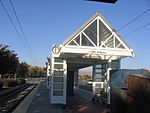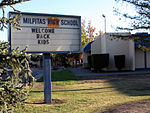The Newby Island Landfill (NISL) is one of the largest active landfills on the shores of the San Francisco Bay. It is located in Santa Clara County, California in the United States. The site is located within the city limits of San Jose, California at the western terminus of Dixon Landing Road. The address is 1601 Dixon Landing Road, Milpitas. Although the address and public street access to the site are both in the City of Milpitas, the landfill property is entirely within the City of San Jose. Newby Island Landfill has a length of 5.07 km (3.15 mi). It is located West of the City of Milpitas near Dixon Landing Road and Interstate 880. It is the terminus for waste for all of San Jose (62%), Santa Clara (14%), Milpitas (10%), Cupertino (5%), Los Altos (2%) and other cities (7%). The 342-acre (138.4 ha) pile is currently permitted to operate until 2041 and may extend up to 245 feet. The landfill is an island surrounded by a levee which keeps its runoff from directly entering the bay, and the water that drains from it is treated in the landfill's own treatment plant. Electricity for the landfill is generated by burning the methane collected from the decomposition of the waste. Dried sewage sludge from the nearby San José–Santa Clara Regional Wastewater Facility is the material used as cover, mixed in with the trash, blending San Jose's waste streams. It is operated by Republic Services (Republic), which, along with Waste Management Incorporated, transports and disposes of most of the household trash in the United States.Materials that pass through the gate of NISL include waste that is disposed in the landfill; clean soil that is used for cover and for temporary roadways; construction and demolition (C&D) debris that is sorted, recycled, and processed for re-use both on-site and elsewhere; and materials that are used for alternative daily cover (ADC), which include but are not limited to biosolids, processed C&D debris, contaminated soil, green waste, and organic material from the on-site composting operations. In addition to C&D waste, bulky recyclables including appliances, tires, carpet, and cardboard are sent to NISL and either are recycled or diverted for beneficial use. Incoming organics received at the landfill are processed (i.e.,ground) and utilized as mulch for erosion control on-site and alternative daily cover or are sent off-site to be used as biofuel, for erosion control, or as a soil additive.The entire site is now called the Newby Island Resource Recovery Park. The site includes both the Newby Island Landfill and the Recyclery.








